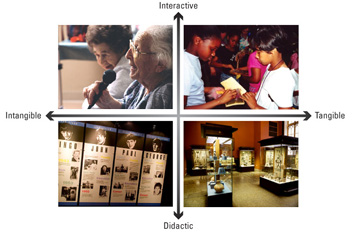 |
|
By Brad King,
Vice President,
Management Consultancy,
Lord Cultural Resources |
Are collections still at the heart of museums? If
so, will that continue to be true in the future, and
in what ways?
This issue of Cultural Capital examines the
changing definitions and uses of ‘collections’
from traditional artifacts, artworks and specimens
to those representing intangible heritage and
living collections. We explore the issue of
relevance and whether collections are still as
central to institutions as they were in the past
– and whether they will remain so in the future.
And we look at these questions in the context of
established institutions holding major collections
and new institutions aspiring to develop them.
To do so, we have asked some leaders in the field
about these issues from the point of view of their
own museums.
Both the definitions and uses for collections
have been expanding. Although art museums still
present works of art for sheer aesthetic pleasure,
the diagram on the right presents a broad range
of options for science, history and natural history
museums, with one axis considering the spectrum
of interpretive approaches, and other the array of
collection types from intangible to tangible.
More traditional methods are found in the lower
right-hand section, where interpretation tends to
emphasize tangible collections used in didactic
ways. Newer approaches
are represented by the
upper left-hand side of
the diagram, where more
interactivity and direct
engagement with the
visitor and less emphasis
on tangible collections
is the rule.
Along with changes in
the ways collections
are defined and used, there are ongoing
changes in collection development practices.
The enormous cost and effort of developing a
‘traditional’ collection – and the heavy cost of
ongoing management and care – means that
many new museums approach the issue very
carefully indeed. The decision to collect is never
taken lightly, and even when the answer is ‘yes’,
acquisitions are often intended for display only.
But this does not necessarily mean that
collections are becoming less relevant. As we
will see, all of the contributors to this issue are
involved in re-visioning existing institutions or
creating completely new ones, and their articles
focus on how collections (however the term may
be defined) can support their institution’s mission.
Mission is the key, and as institutional missions
evolve, so too does the understanding and use of
their collections.
|

Consistent with the environmental education
mission of the Miami Museum of Science,
collections there are used as vehicles of
engagement with current events. Gillian Thomas
has led an effort to expand and relocate this
museum with emphasis on living collections as
bridges between people and contemporary issues
relating to our natural environment. Relevance,
engagement, interactivity and education – all of
these adjectives apply in this case as this longestablished
institution repositions itself for the
21st century.
Some cultural institutions are broadening their definitions
to include a stronger emphasis on intangible collections.
Judith Dueck’s article about the Canadian Museum for
Human Rights illustrates this dynamic new museum’s focus
on ‘stories’ as collection resources, supported as well by
historical objects, works of art, and archival materials.
Again the Museum’s mission to educate and engage
visitors in human rights issues drives the ways in which the
collections are used and defined.
Collections can be weapons in the fight against ignorance,
irrationality and intolerance. Current events will not
allow us to forget that myths, half-truths and outright
falsehoods are often difficult to eradicate. Stephanie
Nolen and Ngaire Blankenberg in their article on the
Museum of AIDS in Africa and Howard Dodson in his piece
on the Schomburg Center for Research in Black Culture
touch on this important theme. For both institutions,
collections are understood as a bulwark – in one case
against misunderstandings relating to the human
immunodeficiency virus, and the other against resurgent
racism. Facts and evidence still matter – indeed, they are
more important than ever in these days of ‘culture wars’
and polarized debate.
In all of these cases, the institutional mission is crucial.
As missions evolve – as museums focus on contemporary
issues, search for ways to make themselves continually
relevant, and seek to engage visitors and encourage them
to explore their personal creativity – they will find creative
ways of building collections and using existing resources.
And they will continue to tap into the enduring power of the
authentic, whether represented tangibly or intangibly.
|